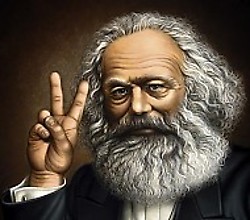|
MORE ON MARX:
Table of Contents for this page
|
|
First the Basics:
A Bit About Marxist Criticism
ASSUMPTIONS:
- Karl Marx argued that the way people think and behave in any society is determined by basic econimic factors.
- In his view, those groups of people who owned and controlled major industries could exploit the rest of the population, through employment and by forcing thier own values and beliefs onto other social groups.
- Marxist criticism applies these arguments to the study of literary texts.
STRATEGIES:
- Explore the way different groups of people are represented in the texts. Evaluate the level of social realism in the text and how society is portrayed.
- Consider how the text itself is a commodity that reproduces certain social beliefs and practices. Analyze the social effect of the literary work.
- Look at the effects of power drawn from economic or social class.
Taken from Deborah Appleman's Critical Encounters in High School English
Applying Marxist Criticism to The Kite Runner:
CHAPTERS 1-4
“In it, I read that my people, the Pashtuns, had persecuted and oppressed the Hazaras. It said the Hazaras had tried to rise against the Pashtuns in the nineteenth century, but the Pashtuns had ‘quelled them with unspeakable violence.’ The book said that my people had killed the Hazaras, driven them from their lands, burned their homes, and sold their women. The book said part of the reason Pashtuns had oppressed the Hazaras was that Pashtuns were Sunni Muslims, while Hazaras were Shi’a. The book said a lot of things I didn’t know, things my teachers hadn’t mentioned” (9).
Understanding some of the history of these two groups, their differences, their shared history, helps readers better understand the power differences between Amir (Pashtun) and Hasan (Hazsra). Without this historical background, Western readers may struggle to understand why Amir treats Hasan as he does, why he struggles with their friendship and differing status. This is particularly evident in chapter 4 when Amir gets pleasure from exposing Hassan’s ignorance (28).
"Then, Baba and I drove off in his black Ford Mustang- a car that drew envious looks everywhere" (27).
This quote shows how the wealth of Amir's family affects how they are seen socially, affected by economic standards. Amir wears western clothing and is more fortunate then many, Hazan included, and because of this he is treated better then those with less then he. Amir remains untouched by the other children of the neighborhood, while Hassan, a servant who dwells in a mud hut, is terrorized by others daily, not only because he is Hazara, but because he is poor. The way the two are treated differently because of their economic class sets up the atmosphere for later events thats change their relationship, beginning with the mistreatement of Hassan and whether or not Amir will stand up for his companion. Changes in their friendship are in part to their economic standings.
RETURN TO KITE RUNNER RESOURCE PAGE
Literary Criticism and The Kite Runner:
Linked below are student developed resources to help readers better understand the depth and complexities of Khaled Hosseini'sThe Kite Runner. These pages were put together in conjunction with our study of literary criticism.
Comments (0)
You don't have permission to comment on this page.